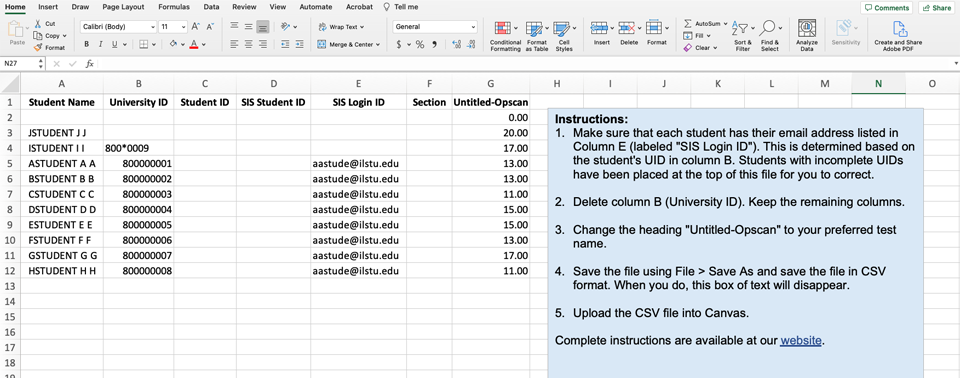Types of Reports
To try and help instructors pick the right reports, we are grouping our reports into basic, intermediate, and specialty categories to help identify those reports that are most useful to the most instructors. We hope this helps clarify the usefulness of all our offerings.
Basic
These reports will be useful for all Opscan patrons.
- 100 - Test Analysis
- 101 - Student Statistics
- 150 - Student Grade
- Excel - Scores for Canvas
- Available as: PDF, Print
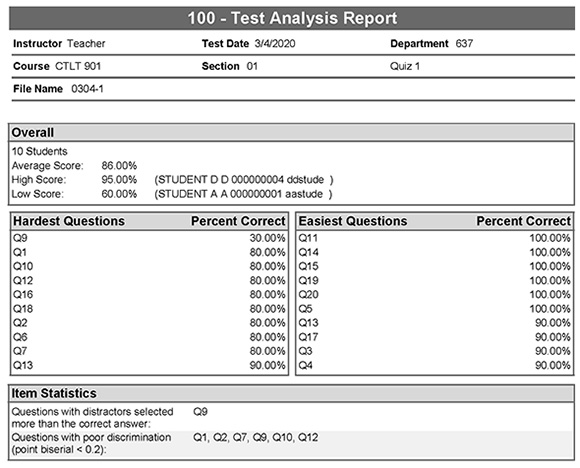
This report presents a summary of several key statistics related to the test. You can quickly find out the highest and lowest scores, the test average, the easiest and hardest questions, and which questions had the most successful distractors (or incorrect answers). It also lists those questions that were poorly correlated with high scores on the test. If you liked the 310 Test Statistics report, you may like this report better.
- Available as: Excel, PDF, Print

This report lists all the students who took the exam with their scores. The scores are shown as both the weighted score and rescaled as if the test was worth 100 points. In addition, the T scores and mean are included.
- Available as: PDF, Print
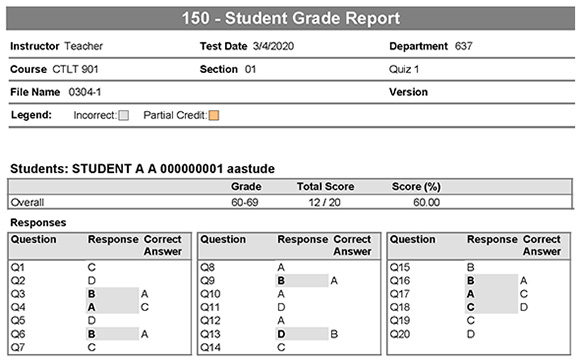
This report will print out a sheet for each individual student. For each question, the student’s selected answer and the correct answer will be shown. Incorrect questions are marked in bold. The score is also printed. You will receive a separate copy of this report for each version of your test and for each class section.
- Available as: Excel
We offer an Excel report that makes it very easy to import grades into Canvas. For full instructions on how to use this report, please visit our online instructions.
Intermediate
These reports delve into either an analysis of how the class did as a whole or an analysis of how students did answering each question on the test.
- 103 - Class Frequency Distribution
- 105 - Student Response
- 203 - Item Analysis Graph
- 204 - Condensed Item Analysis
- RAW - Raw Data
- Available as: PDF, Print
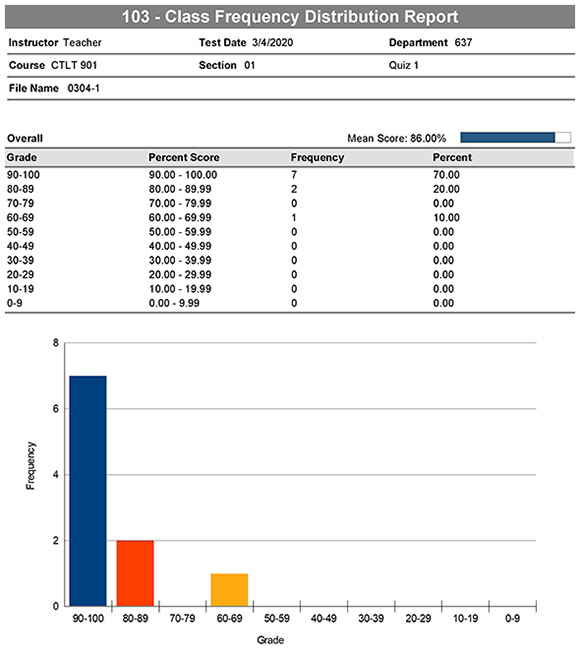
The Frequencies report helps you understand the range of scores in your class. It counts up the scores between specific percentage values—90-100, 80-89, etc.—so you can evaluate how the class performed on the test overall.
- Available as: PDF, Print
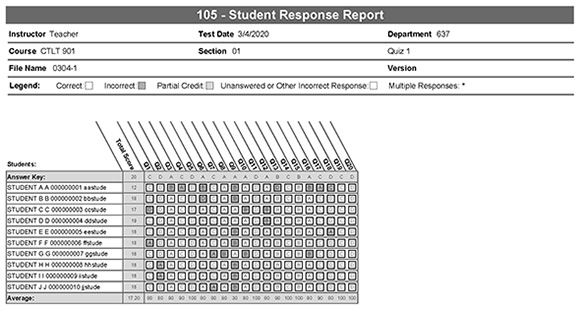
Using this report, you can see the entire class at a glance. Students are listed down the left, questions are listed across the top, and the student responses are shown for each question. Not only do you see all the scores on the test, but you also see what percent of the class answered each question correctly, along the bottom of the report. Incorrect answers are highlighted in gray. You will receive a separate copy of this report for each version of your test and for each class section.
- Available as: PDF, Print

This report shows the item analysis, but in a graphical format. Each question shows you what percentage of the class selected each possible answer and is graphically represented with a histogram. This necessarily requires more paper to print as compared to the condensed test report. You will receive a separate copy of this report for each version of your test and for each class section.
- Available as: PDF, Print
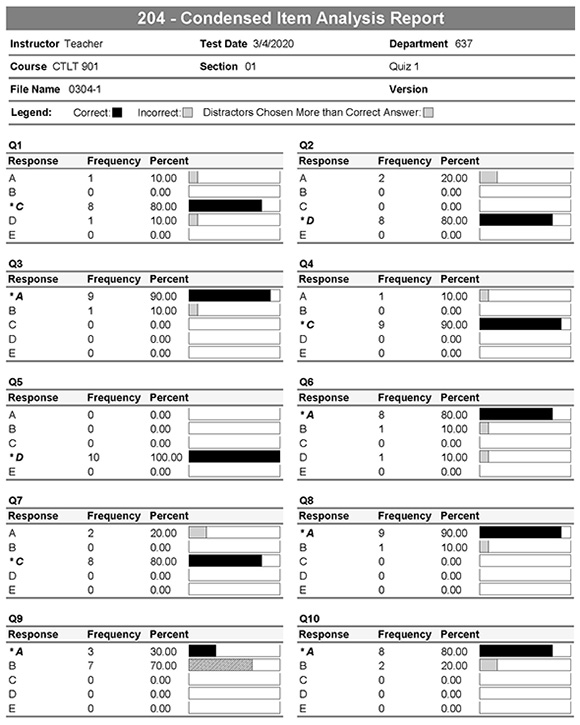
This is another graphical version of the item analysis, but this version provides one additional detail not seen in the item analysis reports listed earlier. On any question, if the students selected one of the incorrect answers more frequently than the correct answer, then that bar in the chart is filled with a horizontal line pattern. For example, in the sample above, question 9 had more people answer B, an incorrect answer, than the correct answer A. This can help identify those questions that may need close checking by the instructor to verify that the question was not poor, they key was not marked correctly, or that content was not sufficiently covered by the course materials. You will receive a separate copy of this report for each version of your test and for each class section.
- Available as: Excel
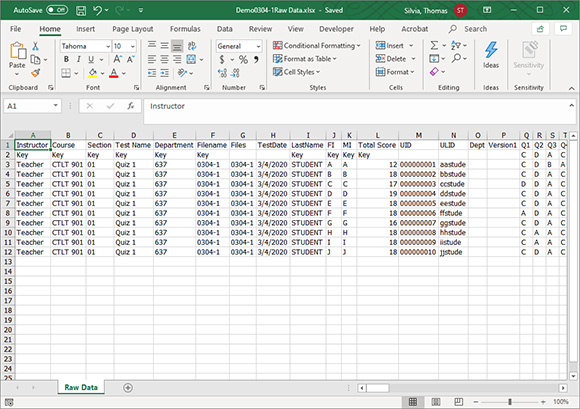
We offer an Excel report that shows the test data in a tabular format. The first row shows the answers from the scanned answer key, with the student records following.
Specialty
These reports provide answers to specific questions, such as how well correlated certain questions were to test scores, some standardized statistics such as the KR20, and which students might need special assistance in gaining confidence in course content.
- 206 - Condensed Test
- 310 - Test Statistics
- 530 - Changed Answer by Student
- Available as: PDF, Print
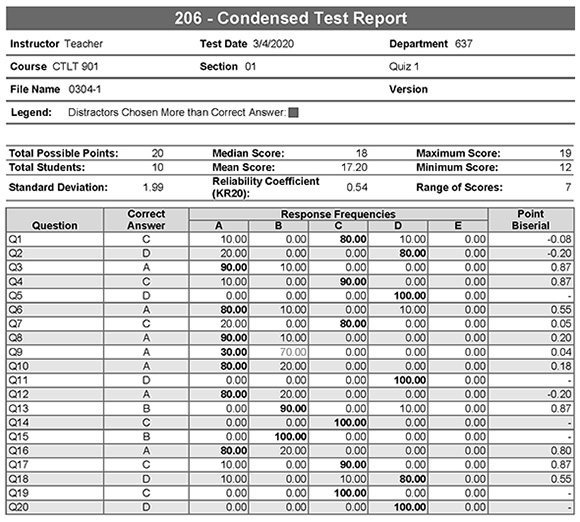
This report is almost identical to our previous short-form item analysis. For each question, you can see what percent of the class answered that question correctly. You can determine which incorrect answers were most popular. And you get the point-biserial statistic, which tells you if this question was well correlated with high scores on the test. You will receive a separate copy of this report for each version of your test and for each class section.
- Available as: PDF, Print

In one place, you can learn a variety of details about your test: the lowest score, the highest score, the mean and median, as well as statistics to help you determine the reliability of your test.
- Available as: PDF, Print
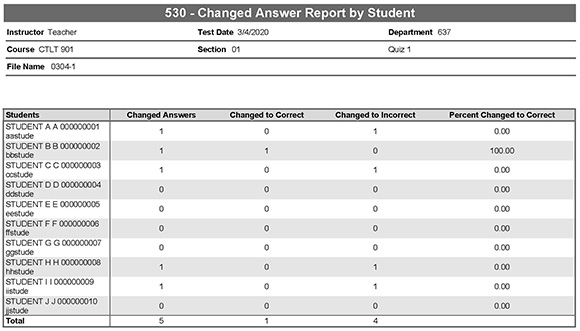
Our scanning software is now able to track how often a student changed answers on test questions. In this report, each student is listed and the number of questions where the student changed the answer is noted, as well as how often the changed answer was correct. This report is meant to highlight those students who might need further assistance in gaining confidence in course content. You will receive a separate copy of this report for each version of your test and for each class section.
